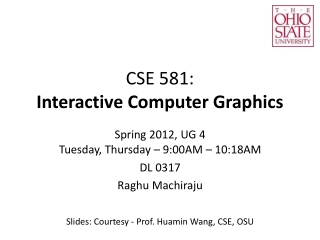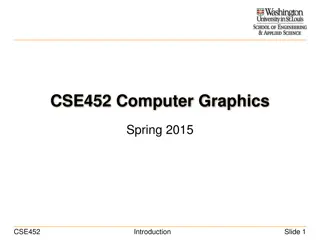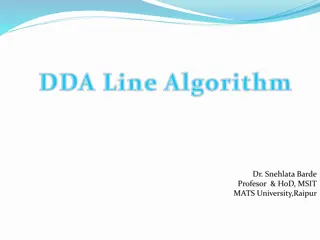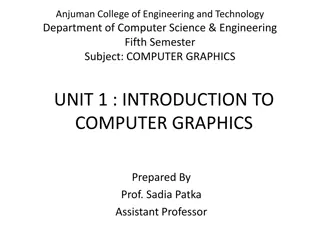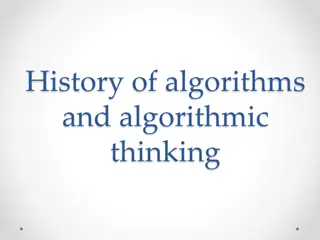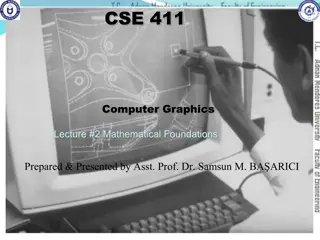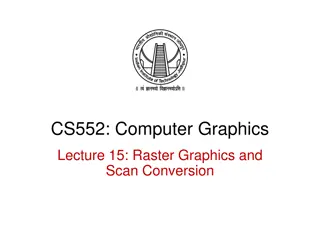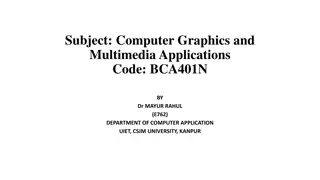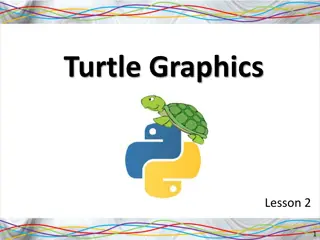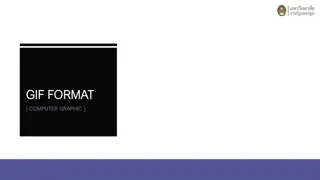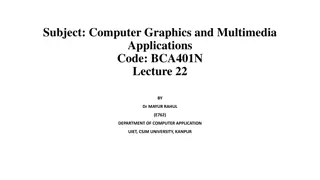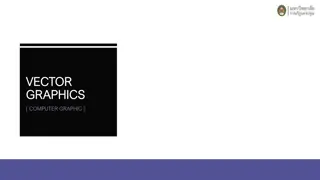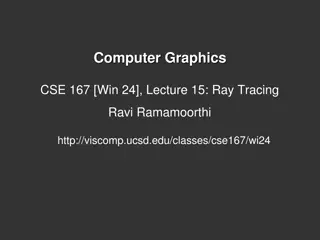Computer Graphics: Evolution and Applications
Computer graphics represent the creation and manipulation of visual information using specialized hardware and software. This field has evolved since the 1950s, enabling diverse applications like entertainment, CAD, education, e-commerce, and computer art. The origins date back to MIT's early display systems, leading to interactive graphics that facilitate user-computer communication. Understanding concepts like Cartesian coordinate systems and graphical user interfaces is crucial in this dynamic field.
Download Presentation

Please find below an Image/Link to download the presentation.
The content on the website is provided AS IS for your information and personal use only. It may not be sold, licensed, or shared on other websites without obtaining consent from the author.If you encounter any issues during the download, it is possible that the publisher has removed the file from their server.
You are allowed to download the files provided on this website for personal or commercial use, subject to the condition that they are used lawfully. All files are the property of their respective owners.
The content on the website is provided AS IS for your information and personal use only. It may not be sold, licensed, or shared on other websites without obtaining consent from the author.
E N D
Presentation Transcript
/ / / Dr. Dr. Farah Farah Qais Qais Al Al- -khalidi khalidi 2020 2020- -2021 2021
Computer Graphics chapter 1 Computer graphics: Graphics are created using computers and the representation of image data by a computer specifically with help from specialized graphic hardware and software. The term computer graphics involves using a computer to create and hold pictorial information and also to adept and manipulate the display in different ways. A computer is capable of sending its output to wide variety of devices, many of which are designed for special purposes. We will concern ourselves with devices that capable of producing graphical output on the computer's display. 1
Computer Graphics chapter 1 Applications of computer graphics Applications of computer graphics Entertainment Entertainment ( Computer- -aided design aided design Computer Presentation Graphics Presentation Graphics Training and Education Training and Education E E- -commerce commerce Computer art Computer art ) ( 2
Computer Graphics chapter 1 The origins of computer graphics: In 1950 the first computer driven display, attached to MIT's computer, was used to generate simple pictures. This display used a Cathode-Ray tube (CRT). Interactive computer graphics made progress and the term computer graphics was first used in 1960. 3
Computer Graphics chapter 1 Interactive Computer Graphics It involves two way communications between computer and user. The computer up on receiving signals from the input device can modify the displayed picture appropriately. The main reason for the effectiveness of interactive computer graphics in many applications is the speed with which the user of the computer can assimilate the display information. 5
Computer Graphics chapter 1 Cartesian coordinate system A coordinate system provides a framework for translating geometric ideas into numerical expressions. In a two-dimensional plane, we pick any point and single it out as a reference point called the origin. Through the origin we construct two perpendicular number lines called axes. These are labeled the X axis and the Y axis. Any point in two dimensions in this X-Y plane can be specified by a pair of numbers, the first number is for the X axis, and the second number is for the Y axis. 6
Computer Graphics chapter 1 Graphical user interface The aspects of the user interface of a program are the parts of the program that link the user to the computer and enable him to control it. A good user interface makes the program not only easy to use and learn but also easier to operate and more efficient. 7
Computer Graphics chapter 1 How the Interactive Graphics display works The modern graphics display is extremely simple in construction. It consists of three components: 1- A digital memory, or frame buffer, in which the displayed image is stored as a matrix of intensity values. 2- A monitor. 3- A display controller, which is a simple interface that passes the contents of the frame buffer to the monitor. Inside the frame buffer the image is stored as a pattern of binary digital numbers, which represent a rectangular array of picture elements, or pixel. The pixel is the smallest addressable screen element. In the simplest case where we wish to store only black and white images, we can represent black pixels by 0's in the frame buffer and white pixels by 1's. 8
The display controller simply reads each successive byte of data from the frame buffer and converts each corresponding video signal. This signal is then fed to the monitor. If we wish to change the displayed picture all we need to do is to change of modify the frame buffer contents to represent the new pattern of pixels. 0 1 and to the
Computer Graphics chapter 1 Graphics system 1- Graphics input Devices 2- Graphics output Devices 3- Processor 4- Memory 5- Frame buffer 9
Computer Graphics chapter 1 Graphics input Devices 1. Mouse and Keyboard 2. Joysticks 3. Data Gloves 4. Touch panels 5. Light pens 6. Image scanners 7. Digitizers 10
Computer Graphics chapter 1 Graphics output Devices Typical examples are plotters, laser printer plotters, films; storage tube and raster scan cathode ray tube (CRT) display. Because the large majority of computer graphics systems utilize some type of CRT display and because most of the fundamental display concepts are embedded in CRT display technology, we will limit our concern to CRT display. CRT display screens consist of three components: 1.The cathode ray tube (CRT), 2.The frame buffer 3.The display controller. 11
Computer Graphics chapter 1 The Cathode Ray Tube(CRT): The CRT used in video monitor is consist of electron gun that contains a cathode that when heated emits a beam of negatively charged electrons towards a positively charged phosphor coated screen. The electron beam passes through the focusing and deflection system, which consist of an electrostatic field. A color CRT has three guns, one for each of three primary colors: red green, and blue. Each pixel is composing of triangular pattern of a red, green, blue phosphor dot. The focusing system concentrates the beam so that by the time the electrons reach the screen. They have converged to small dot. The deflection system which consists of two pairs of deflection plates (horizontal and vertical) directs the electron beam to any point on the screen. 12
Computer Graphics chapter 1 When the electron beam strikes the screen, the phosphor emits a spot of visible light who intensity depends on the number of electrons on the beam. The light on the screen start to fads as soon as the beam moves to another location. The duration of this light , call persistence depend on the type of phosphor that coats the screen in order to give the viewer the appearance of continuous flicker-free image, each illuminated dot on the screen must be intensified many times per second this type is called refresh CRT. Two types of CRT of refresh CRTs are available raster scan and random vector. 13
Computer Graphics chapter 1 Frame buffer Each screen pixel corresponding to a particular entry in a two-dimensional array residing in memory. This memory is called a frame buffer or a bit map. The number of rows in the frame buffer array equals the number of the raster lines on the display screen. The number of columns in this array equals the number of pixels on each raster line. The term pixel is also used to describe the row and column location in the frame buffer arrays that corresponding to the screen location. A 512* 512 display screen requires 262,141 pixel memory locations. Whenever we wish to display a pixel on screen, a specific value is placed into the corresponding memory location in the frame buffer array. 14
Computer Graphics chapter 1 In figure below, a value of 1 placed in a location in the frame buffer results in the corresponding (black) pixel being displayed on the screen. Each screen location pixel and corresponding memory location in the frame buffer is accessed by an (x, y) integer coordinate pair. The x value refers to the column , the y value to the row position. Each pixel in the frame buffer array is composing of a number of bits. A black and white image that has only two intensity levels, on \off, has single bit plane frame buffer. In order to display a color or a black-and white-quality image with shades of gray, additional bit planes are needed. Figure below illustrate a 3-bit plane frame buffer. 15
Computer Graphics chapter 1 Display controller The hardware device that read the contents of the frame buffer into video buffer , which then converts the digital representation of a string of pixel values into analog voltage signals that are sent serially to the video display screen(CRT). 16
Computer Graphics chapter 1 Random Vector-display We ve seen how the raster scan system uses frame buffer to display an image in scan-line: from top to bottom, left to right. This is not only way to create an image using a refresh CRT, indeed if we wish to draw only lines, a line-drawing graphic system is preferred which is call random-vector. In this system there is memory region , called a display file as shown in Figure 3, consisting of line-drawing commands such as draw line from A to B . Either a special display processor or the CPU inserts the correct line-drawing command into the display file. Unlike a raster scan system, it is not necessary to refresh the entire screen but only those parts of the screen where there is a straight line or vector. Draw line AB Draw line BC Draw line CD Draw line DA 17 Display File Display Screen
Vector Scan Display Raster Scan Display 1.In vector scan display the beam is moved between the end points of the graphics primitives. 2 Vector display flickers when the number of primitives in the buffer becomes too large. 3 Vector display characters. Vector display draws continuous and smooth lines. In raster scan display the beam is moved all over the screen one scan line at a time, from top to bottom and then back to top. In raster display, the refresh process is Independent of the complexity of the image. only draws line Raster display has ability to display areas filled with solid colors or patterns. Raster display can display mathematically smooth lines, polygons, and primitives only by approximating them with pixels on the raster grid. Cost is low Graphics primitives are specified in terms of their endpoints and must be scan converted into their corresponding pixels in the frame buffer. 4 boundaries of curved Cost is more. Scan conversion is not required. 5 6 18
Computer Graphics chapter 1 Flat-panel display: Compared to CRT s , flat panel display are much thinner , weight less , consuming less power , and do not emit radiation . Thus they are better for portable computers. There are several types of flat- panel monitors, but the most common is the Liquid Crystal Display (LCD). The disadvantage of LCD is that their image can be difficult to see in bright light . For this reason, laptop computers users often look for shady places to sit when working outdoors or near windows. A bigger disadvantage of LCD monitors is their limited viewing angle. With most CRT, you can see the image clearly even when standing at an angle to the screen. In LCD monitors, the viewing angles shrinks; as you increase your angle to the screen, the image become fuzzy quickly. In many older flat panel systems, the user must face the screen nearly straight on to the image clearly. Technological improvement have extended the viewing angles of flat-panel monitors while causing their price to increase. 19
Computer Graphics chapter 1 Screen clarity The screen clarity depends on three qualities: Resolution , Dot pitch, Refresh rate. 1- Resolution: The clarity or sharpness of the display screen is called resolution, the more pixels per square inch, and the better of resolution. A high resolution graphic has more dots(pixels) per a specific area, while a low resolution graphic has a lower dots or pixels. Resolution applies to both graphics designed for print and graphics created for the display system. A screen with 640 480 pixels multiplied together equals 307200 pixels . the screen will be less clear and sharp than a screen with 800 600(equals 480, 000) or 1024 768(equals 786,432)pixels. Note :- Resolution depends on the type of phosphor, the intensity to be displayed and the focusing and deflection systems used in the CRT. 20
Computer Graphics chapter 1 2- Dot pitch: Is the amount of space between the centers of adjacent pixels, the closer the dots, the crisper the image. For crisp images , dot pitch should less than 0.31 millimeter. On CRTs, the dot pitch is typically from 0.28 to 0.51mm, while large presentation monitors may go up to 1 mm. On LCD monitors, dot pitch is typically from 0.16 to 0.29mm. 3- Refresh rates:- Refresh rate is the number of times per second that the pixels recharged so their glow remains bright. In dual-scan screens, the top and the bottoms of the screens are refreshed independently at twice the rate of single scan screen, producing more clarity and richer colors . in general , displays are refreshed 45 to 100 times per second. 21


